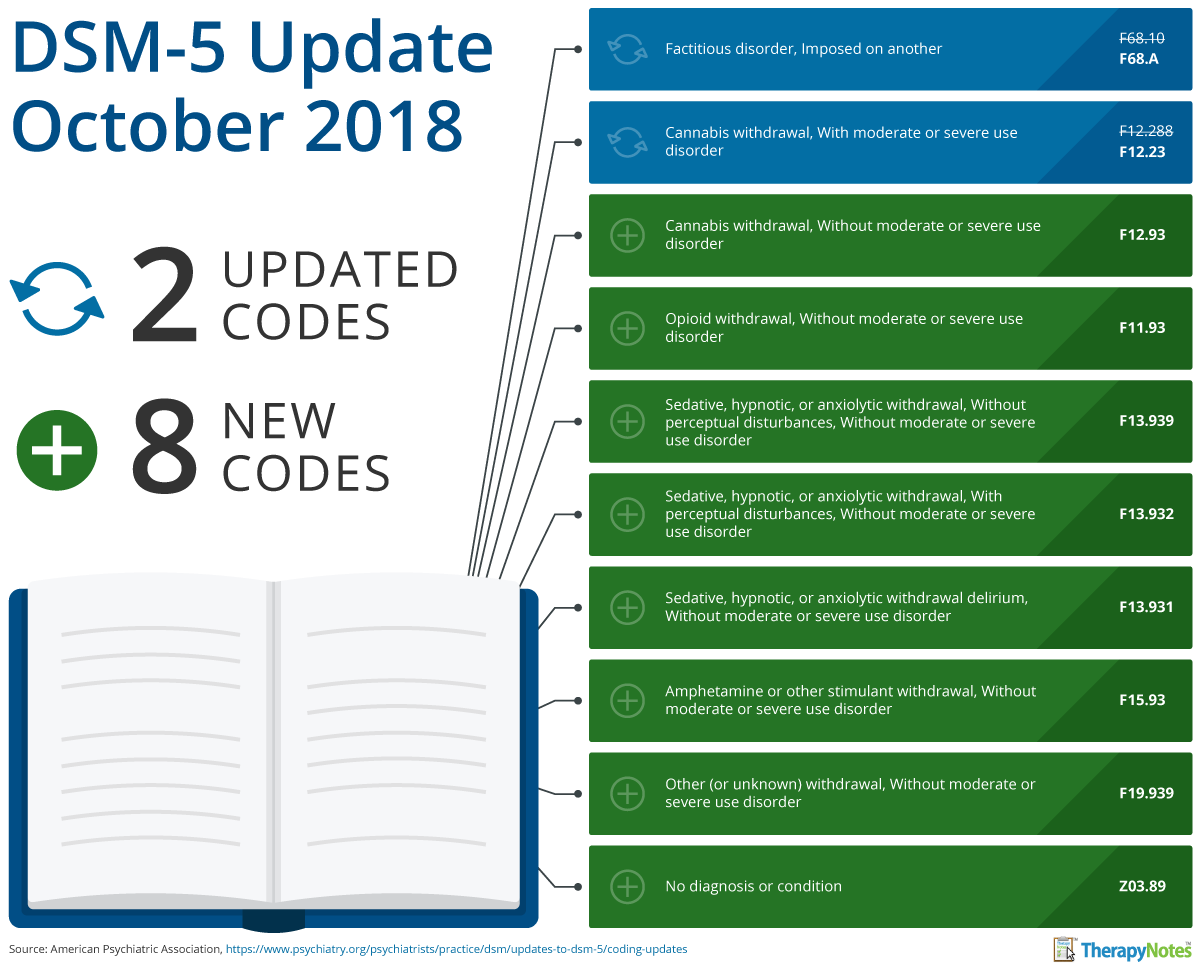Changes to ICD-10 Codes and DSM-5 Diagnoses Effective October 2018
By TherapyNotes, LLC on September 26, 2018

The American Psychiatric Association (APA) has revised the Diagnostic and Statistical Manual of Mental Disorders (DSM-5) to accommodate the latest annual update of the International Classification of Diseases, 10th revision (ICD-10). The DSM-5 outlines the criteria for determining a diagnosis and provides you with a list of the corresponding ICD codes. As a behavioral health professional, the DSM-5 is your best tool for understanding ICD-10 codes.
The coding changes go into effect on October 1, 2018 and include new and updated codes pertaining to withdrawal, a new "Factitious disorder" variation, and the new code Z03.89 for "No diagnosis or condition." Despite the inclusion of Z03.89 in the latest DSM-5 update, this code is available for immediate use.
For a complete list of changes made by the APA, refer to the graphic below or visit psychiatry.org.

| Disorder | Current Code | New Code |
| Factitious disorder, Imposed on another | F68.10 | F68.A |
| Cannabis withdrawal, With moderate or severe use disorder | F12.288 | F12.23 |
| Cannabis withdrawal, Without moderate or severe use disorder | Not in DSM-5 | F12.93 |
| Opioid withdrawal, Without moderate or severe use disorder | Not in DSM-5 | F11.93 |
| Sedative, hypnotic, or anxiolytic withdrawal, Without perceptual disturbances, Without moderate or severe use disorder | Not in DSM-5 | F13.939 |
| Sedative, hypnotic, or anxiolytic withdrawal, With perceptual disturbances, Without moderate or severe use disorder | Not in DSM-5 | F13.932 |
| Sedative, hypnotic, or anxiolytic withdrawal delirium, Without moderate or severe use disorder | Not in DSM-5 | F13.931 |
| Amphetamine or other stimulant withdrawal, Without moderate or severe use disorder | Not in DSM-5 | F15.93 |
| Other (or unknown) withdrawal, Without moderate or severe use disorder | Not in DSM-5 | F19.939 |
| No diagnosis or condition | Not in DSM-5 | Z03.89 |
Information sourced from the American Psychiatric Association at psychiatry.org.
|
|
For TherapyNotes™ Users: Effective the evening of 9/26, TherapyNotes has been updated to reflect these coding changes. Our DSM-5 search includes these updated codes and diagnostic criteria. Be sure to update your clients' diagnosis codes on Treatment Plans when applicable and use the updated codes on notes for dates of service on or after October 1, 2018. |
* The content of this post is intended to serve as general advice and information. It is not to be taken as legal advice and may not account for all rules and regulations in every jurisdiction. For legal advice, please contact an attorney.
Get more content like this, delivered right to your inbox. Subscribe to our newsletter.
More Content You'll Enjoy
The Best Practice Fusion Alternative for Mental Health

Supercharge your Documentation with TherapyFuel!
